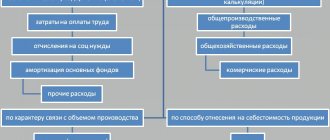General characteristics of 23 accounts
According to the Chart of Accounts for financial and economic activities and the Instructions for its application (approved by order of the Ministry of Finance of Russia dated October 31, 2000 No. 94n), the 23rd accounting account is “Auxiliary production”.
This cost account 23 is intended to summarize information about the costs of production that are auxiliary (auxiliary) in relation to the main production of the organization.
In particular, account number 23 is used to account for production costs that provide:
- supply of different types of energy resources - electricity, steam, gas, air, etc.;
- transport services;
- OS repair;
- production of tools, dies, spare parts;
- production of building parts, structures or enrichment of building materials (more relevant for the construction industry);
- construction of temporary structures;
- extraction of stone, gravel, sand and other non-metallic materials;
- logging, sawing;
- salting, drying and canning of agricultural products, etc.
In addition, account 23 is active.
Note that the balance of account 23 at the end of the month shows the value of work in progress.
Analytical accounting for account 23 is carried out by type of production.
Accounting
Accounting for the costs of auxiliary production is carried out on account 23 “Auxiliary production”.
The debit of account 23 accumulates all expenses that are associated with the activities of auxiliary production: material expenses, labor costs, depreciation and other expenses. These costs, as in primary production, are divided into direct and indirect (general production and general economic). Determine the procedure for classifying specific expenses as direct or indirect on your own based on the organization of production and industry characteristics.
Direct expenses as they arise are recorded in the debit of account 23 in correspondence with the cost accounts for auxiliary production. In this case, do the wiring:
Debit 23 Credit 10 (02, 05, 29, 69, 70...) – direct costs of auxiliary production are taken into account.
This procedure follows from the Instructions for the chart of accounts.
Consider overhead costs as part of the costs of auxiliary production in one of the following ways.
1. Using account 25 “General production expenses”. In this case, first account for such expenses as a debit to this account, and then at the end of the month write them off to account 23. In this case, make the following entries:
Debit 25 Credit 10 (02, 05, 69, 70...) – general production expenses are reflected;
Debit 23 Credit 25 – general production expenses related to auxiliary production are taken into account.
For more information on how to account for general production expenses, see How to write off general production and general business expenses.
2. Bypassing account 25 “General production expenses”. In this case, account for the costs of servicing auxiliary production directly on account 23. Use this option only if it is possible to clearly determine whether such expenses belong to auxiliary production. In this case, do the wiring:
Debit 23 Credit 10 (02, 05, 69, 70...) - reflects general production expenses, the affiliation of which with auxiliary production can be clearly established.
This procedure follows from the Instructions for the chart of accounts.
Consider general business expenses as part of the costs of auxiliary production (i.e., on account 23) if the organization does not immediately recognize them in the cost of products sold (i.e., does not write them off at the end of the month to account 90-2). For more information about this, see How to write off general production and general business expenses. In this case, make the following entries:
Debit 26 Credit 10 (02, 05, 69, 70...) – general business expenses are reflected;
Debit 23 Credit 26 – general business expenses related to auxiliary production are taken into account.
This procedure follows from the Instructions for the chart of accounts.
After the services (work) are provided (performed), write off their cost (i.e., expenses recorded in the debit of account 23) from the credit of account 23 to the accounts for recording production costs or financial results, depending on who is their consumer (Instructions for the chart of accounts). In this case, make entries in correspondence:
– with account 20 “Main production” or account 25 “General production expenses” - if services (work) were provided (performed) to ensure the operation of the main production:
Debit 20 (25) Credit 23 – the cost of services provided (work performed) of auxiliary production is taken into account as part of the costs of main production;
– with account 26 “General business expenses” – if auxiliary production ensured the work of the organization’s management departments:
Debit 26 Credit 23 – the cost of services provided (work performed) of auxiliary production is taken into account as part of the costs of the organization’s management departments;
– with account 29 “Service industries and farms” - if services (work) were provided (performed) to service industries and farms:
Debit 29 Credit 23 – the cost of services provided (work performed) of auxiliary production is taken into account as part of the costs of service industries and farms;
– with account 90 “Sales” or account 91 “Other income and expenses” – if auxiliary production provided services (performed work) to other organizations. Make postings at the time of sale of these services (works):
Debit 62 Credit 90-1 (91-1) – income from the sale of services (works) of auxiliary production is reflected;
Debit 90-2 (91-2) Credit 23 – the cost of services provided (work performed) of auxiliary production is taken into account as part of expenses that reduce income from their sale;
Debit 90-3 (91-2) Credit 68 subaccount “Calculations for VAT” - VAT is charged on the cost of services (work) sold (if this operation is subject to VAT).
For more information on how to take into account income and expenses when selling services (work), see How to record the sale of work (services) in accounting.
This procedure follows from the Instructions for the chart of accounts.
In all cases, calculate the cost of services (work) based on the actual costs of their provision (performance), which are collected in the debit of account 23 (Instructions for the chart of accounts). In this case, use the method of cost accounting and cost calculation that is enshrined in the accounting policy for accounting purposes.
If auxiliary production simultaneously provided services (performed work) to several divisions of the organization (for example, the boiler room of the organization heats production workshops and premises occupied by management structures (accounting, director, etc.)), their cost must be distributed. This is necessary to know what cost of auxiliary production services will increase the costs of the corresponding division of the organization. That is, what amount will be debited to accounts 20, 25, 26, 29. Develop the procedure for distributing the costs of auxiliary production yourself. For example, expenses can be distributed:
- in proportion to the area of premises occupied by the relevant divisions of the organization served by auxiliary production;
- in proportion to the salary of employees working in the relevant divisions of the organization, served by auxiliary production, etc.
Fix the selected option in the accounting policy for accounting purposes (clause 7 of PBU 1/2008).
Auxiliary production can produce spare parts, production and household equipment, etc. In this case, take this property into account as part of the materials (clause 2 of PBU 5/01). Determine their cost based on the actual costs associated with their production (manufacturing), which are collected in the debit of account 23 (clause 64 of the Methodological Instructions approved by Order of the Ministry of Finance of Russia dated December 28, 2001 No. 119n, clause 7 PBU 5/01, Instructions for the chart of accounts). Manufactured spare parts, equipment and other materials should be taken into account:
- account 10 “Materials” - if the organization reflects the receipt of materials at actual cost;
- account 15 “Procurement and acquisition of materials” - if the organization takes into account the receipt of materials at accounting prices.
At the same time, the possibility of using account 10 (15) in this case should be fixed in the accounting policy for accounting purposes. This must be done, since the Instructions for the chart of accounts provide for another option for accounting for property manufactured in-house: on account 43 “Finished products”. Make entries on account 10 (15, 43) on the basis of the invoice request in form No. M-11, which you prepare when transferring materials to the warehouse (clause 57 of the Methodological Instructions approved by Order of the Ministry of Finance of Russia dated December 28, 2001 No. 119n).
Reflect the receipt of materials (spare parts, inventory, etc.) manufactured by auxiliary production by posting:
Debit 10 (15, 43...) Credit 23 – materials (spare parts, inventory, etc.) produced by auxiliary productions arrived at the warehouse.
For more information on how to account for the receipt of materials using account 10 or 15, see How to record the receipt of materials in accounting.
The balance at the end of the month on account 23 will show the value of work in progress (Instructions for the chart of accounts). This situation may arise when work or services are not completed at the end of the month (for example, repairs of production equipment are not completed) (clause 64 of the Regulations on Accounting and Reporting).
How to close account 23
When it is necessary to close account 23, direct expenses directly related to the production of products/performance of work/provision of services are written off to account 23 from the credit of inventory accounts, settlements with employees for wages, etc.
Also see “Accounting for inventories”.
Indirect costs associated with the management and maintenance of auxiliary production are written off in account 23 from the accounts:
- 25 “General production expenses”;
- 26 “General business expenses”.
KEEP IN MIND
If appropriate, production maintenance costs can be taken into account directly on account 23 without prior accumulation on account 25 “General production expenses”.
Losses from defects are written off to account 23 from the credit of account 28 “Defects in production”.
Postings by debit
The debit of account 23 - Auxiliary production - reflects expenses associated with the implementation of the corresponding production process. First of all, these are direct costs, the main of which are:
- Write-off of raw materials and materials:
Dt 23 Kt 10.
You can find more complete information on the topic in ConsultantPlus. Free trial access to the system for 2 days.
- Calculation of wages and contributions to extra-budgetary funds:
Dt 23 Kt 70;
Dt 23 Kt 69.
- Services and works purchased from third parties or individuals:
Dt 23 Kt 60 (76).
In addition, in the debit of the account. 23, part of the overhead costs that relate to the activities of auxiliary production is written off:
- Dt 23 Kt 25 - general production expenses are written off;
- Dt 23 Kt 26 - general business expenses are written off.
The costs of organizing production, if appropriate, can be taken into account directly in the account. 23, without using count. 25.
Subscribe to our newsletter
Yandex.Zen VKontakte Telegram
What about the loan 23 accounts
Here, in transactions on account 23, the amounts of the actual cost of completed products, work performed and services provided are reflected. They are written off from account 23 to the debit of the accounts:
- 20 “Main production” - when releasing products (works, services) to the main production;
- 29 “Service industries and farms” - when releasing products (works, services) to service industries or farms;
- 90 “Sales” – when performing work and services for third parties;
- 40 “Output of products (works, services)” - when using this account to account for production costs, etc.
Sub-accounts opened for account 23
To simplify and structure the process of working with account 23, in accordance with the accounting policy of the enterprise, the following additional second-order accounts can be opened:
- 23-1 “Enterprises providing equipment repairs.” When working with a subaccount, the costs of repairing and updating factory equipment and vehicles, as well as equipping enterprises with the necessary equipment are taken into account;
- 23-2 “Restoration and decoration of buildings.” With the help of a subaccount, the costs of organizing major repairs of structures are recorded;
- 23-3 "Vehicle fleet". The subaccount ensures control of expenses aimed at ensuring the proper operation of agricultural transport;
- 23-4 “Freight and passenger vehicles.” In the process of working with the subaccount, expenses for the maintenance of freight and passenger transport are considered;
- 23-5 "Energy industry". The subaccount takes into account the costs associated with the use of farms producing energy for production needs;
- 23-6 “Providing water resources.” Using a subaccount, specialists control the costs of ensuring optimal conditions for the use of wells with artesian water, reservoirs and all water supply equipment;
- 23-7 "Drawn transport". The subaccount takes into account the costs of maintaining working livestock and using horse-drawn transport;
- 23-8 “Other auxiliary production”. Using a subaccount, the costs of auxiliary production located at the enterprise are calculated.
Features of using 23 accounts
Typically, an enterprise distributes the costs of auxiliary production between types of products, as well as its other divisions (for example, service farms) in proportion to the selected base.
Also see “What an accountant needs to know about service industries and farms.”
The choice of cost distribution base 23 accounts depends on:
- technological specifics of a particular organization;
- its cost structure;
- other factors.
EXAMPLE
Auxiliary costs can be distributed proportionally between types of main production:
- salaries of key production workers;
- the cost of materials released into production;
- the size of production workshops;
- number of personnel, etc.
Read also
19.07.2019
Account 23 “Auxiliary production”: basic postings and examples
In this article we will talk about 23 auxiliary production accounts. Let's see what's special about it compared to the main production account.
Account 23 relates to accounting for auxiliary production. What can you say about him? Well, for example, that this account collects information about the costs and expenses of the enterprise, which are aimed at assisting in the operation of the main production.
Accounting for auxiliary production implies that its finished products do not belong to the products of the main activity, but only help the work of the main production.
The result of ancillary production may be a physical object that will be considered a material raw material for the main production. There may also be a service provided by an auxiliary production to the main one.
The purpose of this article will be to briefly look at how accounting for auxiliary production is organized. To do this, in the chart of accounts we can find account 23 auxiliary production. As always, I immediately suggest looking at the characteristics of this account in the chart of accounts of various 1C programs.
When you look at it, compare what the 23rd account of auxiliary production looks like and the 20th account of the main production.
Let's think a little about what we've seen, what this means, and what we can see when we do our accounting.
Firstly , we see that account 23 is an active account, has sub-accounts, and in accounting 8 also has sub-accounts.
Secondly , the number and name of subaccounts among ordinary accounting and accounting of an agricultural enterprise differ. Of course, in the agricultural program 23 the account is made in much more detail than in previous programs.
Thirdly , we know that the 23rd account of auxiliary production helps the main production, while it is itself a regular production, just like the 20th account. Therefore, we expect that 23 should have the same characteristics as 20.
Characteristics of account 69
On the account 69 reflects information not only on the accrual and payment of monthly payments to state funds, but also penalties and penalties imposed for late and non-payment.
Debit 69 of the account shows the amounts of paid contributions to compulsory medical insurance, the Pension Fund of the Russian Federation and the Social Insurance Fund, funds that are reimbursed to employees of the enterprise upon the occurrence of an insured event, as well as overpaid amounts that were returned by state funds. For loan 69, you can control the accrual of installments that are payable, as well as penalties and fines for late payments.
You can determine whether account 69 is active or passive after analyzing its balance at the beginning and end of the reporting period. Such a balance can show both an overpayment and arrears of payments, therefore it can be a credit or debit, respectively, defining account 69 as active-passive.
Scheme 69
The debit balance reflects the debt incurred by government agencies to the organization. It arises as a result of overpaid insurance premiums and is subject to refund. The emergence of a credit balance occurs as a result of the formation of amounts of accrued but not yet paid contributions. Due to the fact that balances are displayed in the context of subaccounts, you can immediately determine which payments have not been made.
The accounting department of the enterprise has the right to include all accrued contributions as indirect, direct or other costs, depending on the type of settlement with personnel on the basis of which the contributions were paid. Thus, the accrued amounts of payments reduce the taxable profit of the enterprise.
The amounts of insurance payments are accrued monthly when making settlements with personnel, and payment of accruals made is carried out until the 15th of the next month.
Existing subaccounts 69
Account 69, the sub-accounts of which reflect data in the context of state funds receiving payments, shows the accrued and paid amounts of contributions:
- 69-01 - an account for reflecting social insurance payments that are paid to the Social Insurance Fund.
- 69-02 - accounting for pension accruals in favor of the Russian Pension Fund. Depending on the activity of the enterprise, additional sections may be opened on this sub-account to reflect information on contributions for additional payments to certain categories of employees, for example, aviation workers, coal industry organizations, and those employed in work with harmful or difficult working conditions.
- 69-03 - accounting for payments for compulsory health insurance for employees. The subaccount is divided into payments to the Federal Compulsory Medical Insurance Fund and the territorial one.
- 69-07 - contributions to the funded part of the pension, made on the basis of the employee’s application.
- 69-08 - employer contributions for employees to private medical centers.
- 69-11 - an account for accrual (expense) of amounts for insurance against occupational diseases or industrial accidents in favor of the Social Insurance Fund.
Attention! If an enterprise has relationships with other extra-budgetary funds, then accounting provides for the possibility of opening other sub-accounts to simplify the accounting of transactions.
Subaccounts 69










